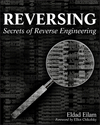
From my experience, the documentation available in the net is often either very specific or largely outdated, hence I decided to give a shot to a all-in-one physical format like a book. I don't regret it a second. I knew the book since some time ago, It's been around since 2005, but I never felt it would report much to what I needed at the time. I couldn't be more wrong. Lately I've been trying to take a look at real life vulnerability code in order to get away from artificial yet educational exploitme-like situations. Most of the time the environment used to be Windows in a 32bit environment, which fortunately is documented on the web. Still, it takes a trained eye to recognize vulnerable portions of code in a sea of mov's,lea's and cmp's. A hands-on reversing lesson was on demand.
At first I was a bit reluctant to the book, the initial chapters are just refreshers for some basic architecture and tool knowledge which is handy considering the solid base they make for the rest of the book. After that it goes to reversing a group of windows undocumented APIs; basic training to recognize C/C++ structures and functions. Then it moves to the topic that interest's us the most: Binary Auditing.
It makes for a good help to pay a visit to our old overflow friends and taking a look at how the look under the cover. The chapter also makes a detailed analysis of the famous IIS Unicode Bug that worked as launchpad to the also known CodeRed worm.
After that came one of the chapters that I had the most fun reading, mostly because I had no previous exposure to it: Malware Analysis. Using a Trojan as example it goes to understand it's internals. Isolated virtual environment is a MUST for this :)
From then on the book continues his way throught cracking, anti-cracking and some protection schemes. Mention deserved to the last chapters dealing with virtual machine based languages using Microsoft's very own .NET platform as example which seemed to me as lightening for other languages such as Java. The book gets completed with 4 Appendixes that make for good reference sections for future reversing sessions.
All in all, a great book, a must have, one of those that takes more than the others to get outdated because not only shows hands-on experience but also shows the path to follow for upcoming techniques developed in the area. After all, reversing is a tool that many different research areas benefit from in greater or lesser way.



No comments:
Post a Comment